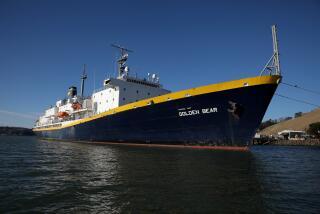Duty in the Rigging Is Top Sailing Test for Tall Ship Cadets
- Share via
Probably the toughest part so far, Wendy Hasselblad said, was the first time she had to climb the high rigging of the three-masted sailing ship.
“Actually, going up wasn’t so bad,” the 20-year-old Coast Guard Academy cadet from Red Wing, Minn., said. “But coming back down, you had to look down.”
Tom Ryan, 22, of Philadelphia, said the hardest part for a lot of his mates was the rough weather the 295-foot square-rigger encountered as it headed south last week from Seattle.
“There were 45- to 50-knot winds, seas of 25 feet,” he said. “There were a fair share of people getting sick over the lee rail.”
The cadets sailed into the Long Beach Naval Station on the homeward leg of a 26,000-mile cruise that began at their academy in New London, Conn., in September.
Cadets interviewed here Wednesday from among the 125 or so aboard the Coast Guard training ship Eagle summed up their overall experience in one word: “Fun.”
The best part of the cruise, most agreed, was the visit to Australia, where the steel-hulled bark and its crew represented the United States during Australia’s bicentennial celebration.
“The people down there really love Americans,” said Greg Tober, 20, a cadet from San Francisco. “The girls, especially, love Americans. That’s really nice.”
“The best part for me was an overnight in the outback with a family,” said cadet Perry Mackey, 20, of Cold Spring, N.Y. “I mean, those were real Australians.”
The Eagle--built as a training ship for the German Navy in 1936 and seized by the United States as a war prize in 1946--made stops in Colombia, Ecuador, Tahiti, Bora Bora, Tonga and Fiji before visiting five ports in Australia between Dec. 20 and Jan. 26.
For a while there were two crews of U.S. Coast Guard cadets in Australia, the one that took the ship there and the present crew, which is bringing the ship back.
The return trip thus far has included visits to American Samoa, Hawaii, Seattle and San Francisco.
The ship will be open to the public from 11:30 a.m. to 7 p.m. today. The Eagle will leave here Friday, with stops scheduled in Acapulco, Panama and Miami before returning to New London on May 3.
“Acapulco? Oh, yes,” Tober said with a grin. “I think we can handle that.”
But Jeanne Quarm, 19, a cadet from Rochester, N.Y., stressed that the training-and-public-relations cruise is not all recreation.
Each cadet must attend classes and take one watch a day--perhaps as a deckhand, perhaps at the helm, or perhaps at some less romantic task, like helping with the cooking or scrubbing the decks.
“It’s a lot of hard work,” Quarm said, showing off her callouses with pride. “It’s not like a pleasure cruise.”
Quarm spent much of Wednesday morning aloft, scrambling about the rigging, helping to reset the sails, as the Eagle led a parade of yachts, cutters, a fireboat and other craft on a two-hour parade up and down Long Beach and Los Angeles harbors before docking at the naval station shortly before noon.
When not aloft, she was laboring on deck, hauling on the heavy sheets and lines used to raise and lower the sails.
Six cadets manned the three big wheels, hooked in tandem, that are used to steer the ship, responding to the commands of the officer of the deck as television cameras filmed the scene.
“Steady on Oh Nine Oh,” the officer shouted.
“Steady up course Oh Nine Oh,” one of the helmsmen responded.
“You say, ‘on,’ not ‘up,’ ” the officer whispered.
“Yes, sir,” the helmsman whispered back.
Hasselblad worked in the galley, making hamburgers and macaroni salad for lunch, while Tom O’Byrne, a 26-year-old from Hobart, Tasmania, took some visitors on a tour below deck.
O’Byrne, who looks like a cadet, is actually a landlubber--a journalist from Tasmania who competed with 12,000 other Australians before winning one of 12 positions aboard the “tall ships” from other nations that joined in the bicentennial celebration. Kay Harvison, a 23-year-old schoolteacher from New South Wales, joined him on the Eagle.
“She and I work as cadets, standing watches, the whole box of dice,” O’Byrne said. “It’s work, but it’s a blast.”
He agreed that going aloft the first time made him “very, very nervous,” but, like Hasselblad, Quarm and most of the others, he said that “eventually, you get used to it.”
Atop the main mast of the Eagle--more than 147 feet above the water--flies a small flag, called the “pennant.”
Most of the way up--past the mainsail, the lower main topsail, the upper main topsail, the main topgallant sail and the main royal sail--there are rope ladders and other handholds to facilitate the climb. But for the last 10 feet or so above that, there’s nothing but smooth, round mast.
“To get to the top, you have to shinny up there,” Quarm said. “Sometime, before this is over, I might just kiss that pennant.”
More to Read
Sign up for The Wild
We’ll help you find the best places to hike, bike and run, as well as the perfect silent spots for meditation and yoga.
You may occasionally receive promotional content from the Los Angeles Times.






